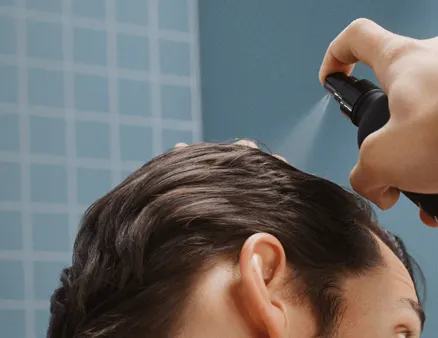Here's what we'll cover
Here's what we'll cover
Hair conditions that cause thinning and baldness are pretty common, but you probably haven’t heard of the inherited hair disease monilethrix. It’s a rare disease that causes the hair strand to thin periodically and have a beaded appearance, leading to sparse hair and balding. Read on to learn more about this condition, how it happens, how to know if you have it, and how to treat it.
What is monilethrix (aka beaded hair)?
Monilethrix is a rare hair condition where the hair periodically thins and thickens, giving it the appearance of beads on a string (hence the origins of its name—monile means necklace and thrix means hair). It typically shows up in early childhood and mainly affects your hair health. Diagnosing monilethrix is relatively simple. A medical provider can examine you and look at the appearance of the hair under a high-powered microscope (Chabchoub, 2022).
People with this condition have hair that’s more fragile and breaks easily, making it look patchy or bald in places (alopecia). This may be because it breaks off from mechanical damage (like washing or brushing), chemical damage, or even right at the scalp as it emerges. Affected individuals might also have brittle nails or skin issues (Chabchoub, 2022).
Monilethrix can look different in different people, even within the same family. Some people may have bald patches only in the back of the scalp (occipital area). In severe cases, others may experience brittle hair and baldness over their entire scalp and body, including their eyebrows, eyelashes, underarm hair, and pubic hair (Zlotogorski, 2006).
What causes beaded hair?
Monilethrix is a genetic disorder. That means it’s not contagious; it’s something you’re born with. We don’t know exactly what causes it, but it’s thought to be caused by mutations in several genes, including ones that tell your body how to produce keratin, the special protein that builds your hair, skin, and nails and gives them strength and elasticity (Chabchoub, 2022).
When this interruption in keratin production happens, the thick inner layer of your hair shaft—the hair shaft cortex—can’t build its keratin chains like it normally would, so parts of the hair strands become thin and brittle where the inner core of the shaft is absent (Chabchoub, 2022).
Monilethrix treatments
There are unfortunately no current cures for monilethrix. However, many people who experience hair thinning find ways to comfortably accept their hair and appearance, especially since balding is so common (even if it’s from other causes).
But if you’re concerned about your hair’s appearance from monilethrix—it can be especially hard for adolescents—there are a few ways you can manage it:
Try Rogaine (minoxidil): Minoxidil is a topical medication that helps to treat hair loss. Several small studies show that low-dose minoxidil helps normal hair grow in problem areas of patients’ scalps, making it a promising treatment option (Rossi, 2011).
Treat your hair gently: Monilethrix causes hair to become dry and very brittle at its thin spots, making it more likely to break off from mild trauma like hair brushing, scratching, aggressive washing, and using tight hair ties. It’s also more vulnerable to chemical damage. Try to brush very gently or use a wide-tooth comb, gently braid it instead of putting it in a tight ponytail, and avoid treating it with dyes or chemicals (Chabchoub, 2022).
Wait and see: Interestingly, in people with monilethrix, better hair growth seems to happen in the summertime, during puberty, and during pregnancy. It may be that your or your child’s hair can thicken during these times, and when growth slows down again, you can treat it gently or with hair loss treatments to maintain it as long as possible (Chabchoub, 2022).
Other treatments are being studied for monilethrix, including oral acitretin, which (in one study on one person) showed that it both stopped hair splitting and prompted hair growth. However, the improvement only lasted as long as treatment did, and more research is needed (Karincaoglu, 2005).
Oral Minoxidil Important Safety Information: Read more about serious warnings and safety info.
Can you prevent monilethrix?
Monilethrix is an inherited condition, and it’s not totally clear when someone will inherit it or not. It can’t be prevented or predicted, but fortunately, it doesn’t seem to cause other health problems. It can be associated with other conditions that also affect skin and nails (Chabchoub, 2022).
DISCLAIMER
If you have any medical questions or concerns, please talk to your healthcare provider. The articles on Health Guide are underpinned by peer-reviewed research and information drawn from medical societies and governmental agencies. However, they are not a substitute for professional medical advice, diagnosis, or treatment.
Chabchoub, I. & Souissi, A. (2022). Monilethrix. StatPearls. Retrieved on May 6, 2022 from https://www.ncbi.nlm.nih.gov/books/NBK539813/
Karincaoglu, Y., Coskun, B. K., Seyhan, M. E., & Bayram, N. (2005). Monilethrix: Improvement with acitretin. American Journal of Clinical Dermatology, 6 (6):407-10. doi:10.2165/00128071-200506060-00008. Retrieved from https://pubmed.ncbi.nlm.nih.gov/16343029/
Rossi, A., Iorio, A., Scali, E., et. al. (2011). Monilethrix treated with minoxidil. International Journal of Immunopathology and Pharmacology, 24( 1):239-42. doi:10.1177/039463201102400129. Retrieved from https://journals.sagepub.com/doi/pdf/10.1177/039463201102400129
Zlotogorski, A., Marek, D., Horev, L., et. al. (2006). An autosomal recessive form of monilethrix is caused by mutations in DSG4: Clinical overlap with localized autosomal recessive hypotrichosis. Journal of Investigative Dermatology, 126 (6):1292-6. doi:10.1038/sj.jid.5700251. Retrieved from https://pubmed.ncbi.nlm.nih.gov/16575393/










